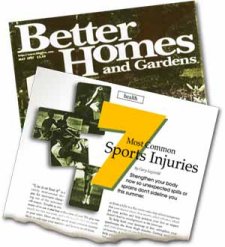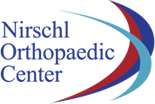Dr. Nirschl is interviewed by the author of an article about common sports injuries, the topic: Tennis Elbow. Also discussed is Dr. Nirschl’s latest book, Arm Care.
 Better Homes & Gardens
Better Homes & Gardens
May 1997
7 Most Common Sports Injuries
By Gary Legwold
Shinsplints
This general term is used to describe pain on the inner side of the middle third of the shin bone. Shinsplints can be caused by running or jumping on hard surfaces,
wearing worn-out shoes, or increasing intensity too fast while training.
The shin bone is the attachment site for muscles used to help raise the arch of the foot. Insufficient arch support or too-tight calf muscles strains these
arch-raising muscles and the attached tendons, causing mild to sharp pain.
Shinsplints often occur in people who aren’t used to exercise, says Robert Nirschl, M.D., of the Nirschl Orthopedic Clinic at Virginia Hospital Center Arlington in
Arlington, Virginia. Wearing good shoes with solid arch support often solves the problem. Also, using the 10 percent rule ensures that you don’t increase training
too fast. Other ways to prevent and treat shinsplints: cross-training, ice, orthotics, anti-inflammatories, and strengthening and stretching of lower leg muscles.
Tennis/Golf Elbow
When the tendons and muscles on the outside of your elbow are repeatedly overloaded in the backhand stroke of tennis, the result is a tendon degeneration called tennis
elbow. Golf elbow occurs when poor strokes result in jarring divots and when golfers try to “muscle the ball,” says Dr. Nirschl, author of Arm Care (Medical Sports
Publishing, 1996). Golf elbow can occur on either elbow – on the outside of the leading elbow (the left arm for right-handers) or the inside of the trailing elbow
(the right arm).
RICE and anti-inflammatory medication are routinely prescribed with these elbow ailments. But pills and rest don’t heal the tissue, says Dr. Nirschl. “They are temporary
comforters, not a cure,” he says.
Forearm-strengthening exercises help on healing. Examples: Wrist curls (palm facing forward) and reverse curls (palm facing backward) using light weights are great. Do
several repetitions. Squeezing a soft rubber ball until arm fatigue stes in also builds strength.
Equipment adjustments are important in tennis elbow. Dr. Nirschl recommends using a raquet of medium flexibility and somewhat loose string tension. Also, try a larger
grip; a too-small grip may cause you to squeeze the raquet too hard, which cause strain.
Elbow braces also can help inpreventing a stranglehold grip and in dampening the impact forces that travel from the raquet up your arm. “Even when I go to the hardware
store I look for a hammer that fits my hand,” Dr. Nirschl says. “The employees kind of look at me like I’m nuts.”
But the best help for tennis or golf elbow doesn’t come from a doctor. He or she can’t advise you in tennis, for example, about too much topspin and late hits with
bent-elbow backhands. Bad technique brings about bad elbows no matter what medical advise you receive, says Dr. DiNubile. “I tell some of my patients that they’d do
better taking lessons from a tennis pro than to keep coming back to me.”
